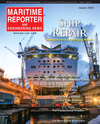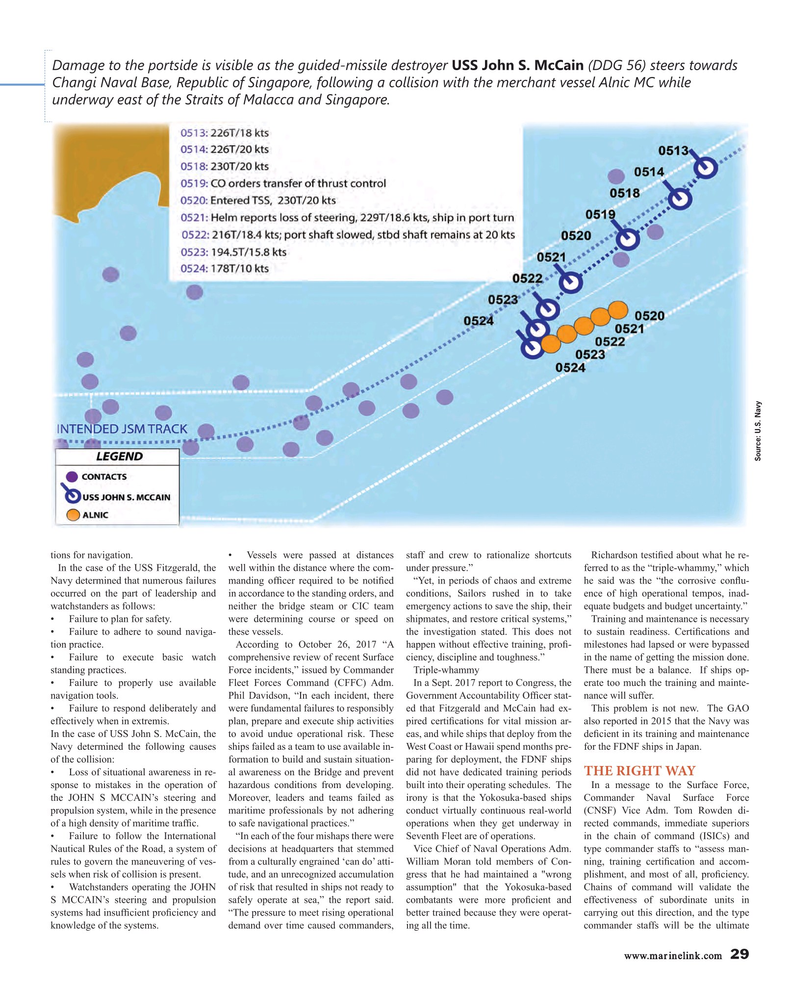
Page 29: of Maritime Reporter Magazine (January 2018)
Ship Repair & Conversion
Read this page in Pdf, Flash or Html5 edition of January 2018 Maritime Reporter Magazine
Damage to the portside is visible as the guided-missile destroyer USS John S. McCain (DDG 56) steers towards
Changi Naval Base, Republic of Singapore, following a collision with the merchant vessel Alnic MC while underway east of the Straits of Malacca and Singapore.
Source: U.S. Navy tions for navigation. • Vessels were passed at distances staff and crew to rationalize shortcuts Richardson testi? ed about what he re-
In the case of the USS Fitzgerald, the well within the distance where the com- under pressure.” ferred to as the “triple-whammy,” which
Navy determined that numerous failures manding of? cer required to be noti? ed “Yet, in periods of chaos and extreme he said was the “the corrosive con? u- occurred on the part of leadership and in accordance to the standing orders, and conditions, Sailors rushed in to take ence of high operational tempos, inad- watchstanders as follows: neither the bridge steam or CIC team emergency actions to save the ship, their equate budgets and budget uncertainty.” • Failure to plan for safety. were determining course or speed on shipmates, and restore critical systems,” Training and maintenance is necessary • Failure to adhere to sound naviga- these vessels. the investigation stated. This does not to sustain readiness. Certi? cations and tion practice. According to October 26, 2017 “A happen without effective training, pro? - milestones had lapsed or were bypassed • Failure to execute basic watch comprehensive review of recent Surface ciency, discipline and toughness.” in the name of getting the mission done. standing practices. Force incidents,” issued by Commander Triple-whammy There must be a balance. If ships op- • Failure to properly use available Fleet Forces Command (CFFC) Adm. In a Sept. 2017 report to Congress, the erate too much the training and mainte- navigation tools. Phil Davidson, “In each incident, there Government Accountability Of? cer stat- nance will suffer. • Failure to respond deliberately and were fundamental failures to responsibly ed that Fitzgerald and McCain had ex- This problem is not new. The GAO effectively when in extremis. plan, prepare and execute ship activities pired certi? cations for vital mission ar- also reported in 2015 that the Navy was
In the case of USS John S. McCain, the to avoid undue operational risk. These eas, and while ships that deploy from the de? cient in its training and maintenance
Navy determined the following causes ships failed as a team to use available in- West Coast or Hawaii spend months pre- for the FDNF ships in Japan.
of the collision: formation to build and sustain situation- paring for deployment, the FDNF ships
THE RIGHT WAY • Loss of situational awareness in re- al awareness on the Bridge and prevent did not have dedicated training periods sponse to mistakes in the operation of hazardous conditions from developing. built into their operating schedules. The In a message to the Surface Force, the JOHN S MCCAIN’s steering and Moreover, leaders and teams failed as irony is that the Yokosuka-based ships Commander Naval Surface Force propulsion system, while in the presence maritime professionals by not adhering conduct virtually continuous real-world (CNSF) Vice Adm. Tom Rowden di- of a high density of maritime traf? c. to safe navigational practices.” operations when they get underway in rected commands, immediate superiors • Failure to follow the International “In each of the four mishaps there were Seventh Fleet are of operations. in the chain of command (ISICs) and
Nautical Rules of the Road, a system of decisions at headquarters that stemmed Vice Chief of Naval Operations Adm. type commander staffs to “assess man- rules to govern the maneuvering of ves- from a culturally engrained ‘can do’ atti- William Moran told members of Con- ning, training certi? cation and accom- sels when risk of collision is present. tude, and an unrecognized accumulation gress that he had maintained a "wrong plishment, and most of all, pro? ciency. • Watchstanders operating the JOHN of risk that resulted in ships not ready to assumption" that the Yokosuka-based Chains of command will validate the
S MCCAIN’s steering and propulsion safely operate at sea,” the report said. combatants were more pro? cient and effectiveness of subordinate units in systems had insuf? cient pro? ciency and “The pressure to meet rising operational better trained because they were operat- carrying out this direction, and the type knowledge of the systems. demand over time caused commanders, ing all the time. commander staffs will be the ultimate www.marinelink.com 29
MR #1 (26-33).indd 29 MR #1 (26-33).indd 29 1/9/2018 12:35:45 PM1/9/2018 12:35:45 PM

 28
28

 30
30
